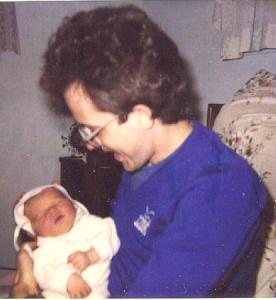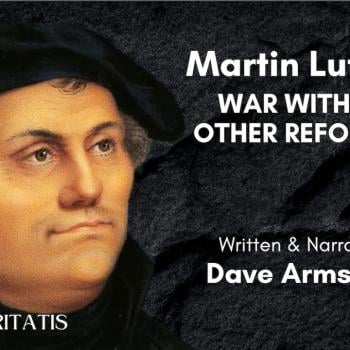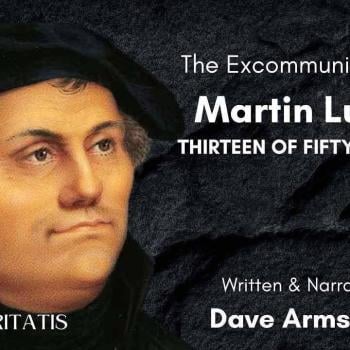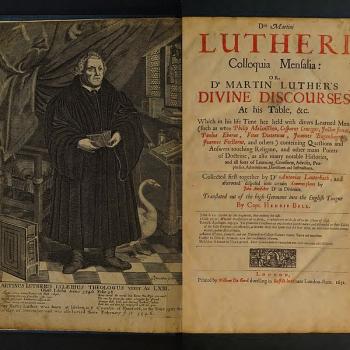Part Seven: Ecclesiology (the Church), the “Protestant Myth” of Church History, and My Vehement Opposition to Catholic Infallibility (1990)

This is the ten-part story of my complete religious history, from nominal Methodism (1958-1967), to the occult and practical atheism (1968-1976), through evangelical Protestantism, counter-cult, pro-life, evangelistic, and apologetics work (1977-1990), and finally on to the fullness of the Catholic faith in 1991. It is found complete (75 pages) in my 2013 book, Catholic Converts and Conversion.
See All Ten Parts:
Part One: Nominal Methodism, Occult, and the Seeds of a Serious Christian Commitment (1958 – early 1970s)
Part Two: Nature Mysticism, Romanticism, Bible Movies, and the “Great Depression” (1968-1977)
Part Three: Evangelical “Born-Again” (?) Experience, More Lukewarmness, and Personal Revival (1977-1982)
Part Four: Apologetics, Abundant Evangelical Blessings, and Protestant Evangelistic Campus Ministry (1983-1989)
* * * * *
“The Church” and Inconsistent Protestant Ecclesiologies
By July 1990, I believed Catholicism had the best moral theology of any Christian body, and greatly respected its sense of community, devotion, and contemplation. I was also seriously reflecting upon the issue of the nature of the Church, because I believed (in some as-yet undefined or worked-through sense), that there was such a thing as the Church, with a big “C.”
I found it fascinating (looking back), that when I was in evangelical counter-cult ministry, they habitually referred to things like: “the early Church condemned Arianism in the Council of Nicaea.” This notion of the Church was casually assumed.
But then somehow this terminology got lost after Luther came onto the scene; all of a sudden, now evangelicals are reluctant to talk about the Church (in the present time), because they know it usually refers to us. Catholics and Orthodox are the only ones who use that terminology.
I started wondering how all that worked out. I had a view that the early Church was Protestant. It became corrupt with the Inquisition and the Crusades, and then Martin Luther picked up the ball in the 1500s and it sort of “switched over” to Protestantism at that point.
I thought that the Catholic Church was truly Christian, but it wasn’t what I would call the mainstream. The evangelicals were really where it was at – the cream of the crop – and Catholics had a lot of truth, but not enough. Individual Catholics could still be saved (what we would call “real Christians”), but they were in a different league: sort of Class B. That’s how I thought as an evangelical who was not anti-Catholic, yet very pro-Protestant.
My view of the Church and Church history as an evangelical has to be understood in a little more depth, before I describe how I was persuaded that it was an inadequate understanding, and not in line with the actual history of the Church: especially her doctrinal history.
Strong Advocacy of the “Protestant Myth” of Church History
As a committed evangelical Protestant with a great respect for the history of Christian doctrine, I subscribed to a fairly widespread non-Catholic view of Church history: a vague, ethereal, semi-legendary conception of the early Church as quasi-Protestant, and lacking those elements that are now called “Catholic distinctives.”
If the early Christians weren’t technically and exhaustively Protestant (as defined theologically and ecclesiologically by the revolutionary movement in the 16th century), they certainly (in the main, anyway) weren’t Catholic — or so I had casually assumed. They were “proto-Protestants.”
Many Protestants (particularly evangelicals) date the downfall of the early Church at 313, with the conversion of the Roman emperor Constantine and the subsequent “paganization” of institutional Christianity. Others place this alleged calamitous event at around 440, with the beginning of the papal reign of Pope St. Leo the Great, who — in the eyes of many Protestant historians — was the first pope in the full-blown jurisdictional sense (however that is defined by these same historians).
Still another school of thought believes that the derailing of the young Christian Church occurred soon after the last apostle’s death and the cessation of the writing of New Testament books, around the year 100, or else sometime during the course of the second century A. D. at the latest.
This impossible endeavor to date the “apostasy” of institutional, historic Christianity strongly reminds me of arbitrary attempts to maintain that human life or personhood in the womb begins at a time other than conception: clearly the determinative biological event. It simply can’t be done with any logical or historiographical rigor.
The Church, like a human soul and body in the womb, organically develops from the beginning in a gradual, consistent fashion, and it is altogether futile to try and assign a date to its supposed demise. Like the preborn child, the essence is there from the first.
Intuitively sensing this, I myself took a more complex, nuanced view that the ostensible “Church” was truly Christian all through this period, down through the early Middle Ages, up to the period of the Inquisition and Crusades (roughly 1100-1500), at which time it did, however, lose much of its integrity and moral authority, if not the title and claim “Christian” altogether.
“Second-Class” Christianity (Catholicism) But Still Christian!
I was quite reluctant to go the whole way and claim that Catholicism wasn’t Christian (as the anti-Catholic wing of Reformed Protestantism so often does), because I knew too much (from my counter-cult background) about what it had always taught on the “central doctrines” of Christianity, such as the Trinity and all the Christological doctrines, and its indispensable role in preserving both medieval culture and the Bible itself.
To deny Christian status to Catholicism at any point of its development would be to cut off the limb on which Protestantism sits: in effect, this would logically reduce to a very curious and self-defeating standpoint that Christianity is not an historical religion by its very nature. I later developed this line of argument in great detail, in my Catholic apologetics writing.
Rather, I believed that the Catholic Church had “passed the baton,” so to speak, to the Protestants in the sixteenth century, who succeeded in reforming the Church universal. In other words, I held to an “organic” conception of Church history, somewhat like the Protestant Church historian Philip Schaff, and many Reformed, Anglican and Lutheran theologians and historians, whereby Protestantism was a legitimate development of, heir to, and legatee of, historic Catholicism. It was a “higher” and more developed version of Christianity.
Henceforth, in my thinking, Protestantism became the superior and more “biblical” form of Christianity, since the Catholic Church had “obviously” (so I thought) compromised itself both morally and theologically with its reactionary and extremely harsh, “un-ecumenical” Council of Trent in the sixteenth century.
My Biggest “Bugaboo” and Objection, by Far: Infallibility
Getting back to the narrative of my continuing evolution of thought: we kept talking at my discussion groups (in the first half of 1990), and I would try to shoot down the idea of infallibility. This was, by far, my biggest objection to Catholicism: the infallibility of the Church and the pope (with a particular aversion to the Inquisition and the Crusades).
I’d say, half tongue-in-cheek, “Okay, you guys can be the Church, or a Church, but you’re not infallible.” I thought that was totally out of the question: it just couldn’t be: there were too many errors, and there was the scandal of the Inquisition, and so forth.
My friend John McAlpine, whom I had met in the pro-life movement, and with whom I greatly enjoyed conversing, stunned me one night at my ecumenical discussion group when he claimed that the Catholic Church had never contradicted itself in any of its dogmas.
This, to me, was self-evidently incredible and a priori implausible, and so I embarked immediately on a massive research project designed to debunk once and for all this far-fetched notion that any Christian body could even rationally claim infallibility, let alone actually possess it. Spurred on by this “intellectual agitation,” I visited the library at Sacred Heart Seminary in Detroit, trying to shoot down the Catholic Church.
I quickly found some of the leading polemics against Catholic infallibility, such as the Irish Anglican anti-Catholic George Salmon (1819-1904), author of The Infallibility of the Church (1888) and Johann Joseph Ignaz von Döllinger (1799-1890), the German historian who rejected the ex cathedra declaration of papal infallibility and formed the Old Catholic schismatic group. His books, Letters of Quirinus and Letters of Janus, were written during the First Vatican Council in 1870.
Salmon’s work has been refuted decisively twice, by B.C. Butler, in his The Church and Infallibility: A Reply to the Abridged “Salmon” (New York, Sheed & Ward, 1954), and also in a series of articles in The Irish Ecclesiastical Record, in 1901 and 1902 (probably able to be found online).
Yet Protestant apologists Norman Geisler and Ralph MacKenzie still claimed in 1995, in a major critique of Catholicism, Roman Catholics and Evangelicals: Agreements and Differences (Grand Rapids, Michigan: Baker Books, p. 206; cf. p. 459) that Salmon’s book has “never really been answered by the Catholic Church” and is the “classic refutation of papal infallibility.”
Prominent professional anti-Catholic James White, in the same year, claimed that I must have never been familiar with the best Protestant arguments against infallibility and Catholicism in general — hence my eventual conversion on flimsy grounds.
The truth was quite otherwise: the above works are the cream of the crop of this particular line of thought, as evidenced by Geisler and MacKenzie’s citation of both Salmon and Küng as “witnesses” for their case (ibid., pp. 206-207). Church historian Döllinger’s heretical opinions are also often utilized by Eastern Orthodox apologists as arguments against papal infallibility.
Using these severely biased, untrustworthy sources, I found the typical arguments used: for example, Pope Honorius, who supposedly was a heretic. I produced two long papers containing difficult “problems” of Catholic history and alleged contradictions and so forth (just as atheists love to do with the Bible), to “torment” my Catholic friends at the group discussions.
George Salmon revealed in his book his profound ignorance, not only concerning papal infallibility, but also with regard to even the basics of the development of doctrine:
Romish advocates . . . are now content to exchange tradition, which their predecessors had made the basis of their system, for this new foundation of development . . . The theory of development is, in short, an attempt to enable men, beaten off the platform of history, to hang on to it by the eyelids . . . The old theory was that the teaching of the Church had never varied. (The Infallibility of the Church, Grand Rapids, Michigan: Baker Book House [originally 1888], pp. 31-33; cf. pp. 35, 39)
Here Salmon is quixotically fighting a straw man of his own making and seeking to sophistically force his readers into the acceptance of a false and altogether logically unnecessary dichotomy. He contended that development of doctrine implies change in the essence of a doctrine and therefore is utterly contrary to the claims of the Church to be the guardian and custodian of an authoritative tradition of never-changing dogma.
But this is emphatically not the Catholic notion, nor that of Cardinal Newman, to whom Salmon was largely responding. Nor is it true that development was a “new” theory introduced by Cardinal Newman into Catholicism, while the “old theory” was otherwise. This is proven by the writing of St. Vincent of Lerins, one of the Church fathers, who died around 450 A. D., in his classic patristic exposition of development, The Notebooks:
Will there, then, be no progress of religion in the Church of Christ? Certainly there is, and the greatest . . . But it is truly progress and not a change of faith. What is meant by progress is that something is brought to an advancement within itself; by change, something is transformed from one thing into another. It is necessary, therefore, that understanding, knowledge and wisdom grow and advance strongly and mightily . . . and this must take place precisely within its own kind, that is, in the same teaching, in the same meaning, and in the same opinion. The progress of religion in souls is like the growth of bodies, which, in the course of years, evolve and develop, but still remain what they were . . . Although in the course of time something evolved from those first seeds and has now expanded under careful cultivation, nothing of the characteristics of the seeds is changed. Granted that appearance, beauty and distinction has been added, still, the same nature of each kind remains. (23:28-30; cited from William A. Jurgens, The Faith of the Early Fathers; Collegeville, Minnesota: The Liturgical Press, 1979, vol. 3, p. 265)
St. Augustine (354-430), the greatest of the Church fathers, whom Protestants also greatly revere, expressed similar sentiments in his City of God (16, 2, 1), and On the 54th Psalm (number 22). The (explicit) concept predated Newman by at least fourteen centuries, Salmon’s claims notwithstanding.
George Salmon thus loses much credibility as any sort of expert on Christian history, papal infallibility, or development, for this and many other reasons, as demonstrated by his Catholic critics. Yet Geisler and MacKenzie, while presenting a fairly accurate picture of Newman’s (and Catholic) development of doctrine, state that Salmon’s book is “a penetrating critique of Newman’s theory” (ibid., p. 459).
It is beyond our purview here to examine the faulty and jaundiced reasoning employed by the above-cited “anti-infallibility” works, and my own ambitious and zealous adoption of them, in my effort to refute the Catholic Church on historical grounds. Suffice it to say that it is largely a matter of misunderstanding or misapplying the true doctrine of infallibility, as defined dogmatically by the First Vatican Council in 1870, or else a conveniently selective and dishonest presentation of historical facts and patristic citations.
These practices run rampant throughout the current anti-Catholic literature, and always have. I was guilty of it, myself. Bias has a way of blinding one to even basic logical errors. The First Vatican Council of 1870 defined papal infallibility as follows:
We teach and define that it is a dogma divinely revealed: that the Roman Pontiff, when he speaks ex cathedra, that is, when, in discharge of the office of pastor and teacher of all Christians, by virtue of his supreme Apostolic authority, he defines a doctrine regarding faith or morals to be held by the universal Church, is, by the divine assistance promised to him in Blessed Peter, possessed of that infallibility with which the divine Redeemer willed that His Church should be endowed in defining doctrine regarding faith or morals; and that, therefore, such definitions of the Roman Pontiff are of themselves, and not from the consent of the Church, irreformable.
The conciliar definition was careful to limit absolute infallibility to very specific and strict parameters, and these are almost always overlooked or distorted by anti-Catholic polemicists when bringing to the table such famous examples of supposed papal fallibility as Honorius, Vigilius and Liberius.
None of theses “disproofs” succeed when subjected to the proper historical and logical scrutiny. They only “work” when presented in isolation without the Catholic counter-replies that reveal their utter inadequacy.
Furthermore, the Second Vatican Council (1962-1965) did not change this teaching in the slightest, despite the claims of misinformed non-Catholics and nominal, undereducated, or dissident Catholics. Referring to the decree on papal infallibility from Vatican I, the council declared:
This teaching concerning the institution, the permanence, the nature and import of the sacred primacy of the Roman Pontiff and his infallible teaching office, the sacred synod proposes anew to be firmly believed by all the faithful . . . The college or body of bishops has for all that no authority unless united with the Roman Pontiff, Peter’s successor, as its head, whose primatial authority, let it be added, over all, whether pastors or faithful, remains in its integrity. For the Roman Pontiff, by reason of his office as Vicar of Christ, namely, and as pastor of the entire Church, has full, supreme and universal power over the whole Church, a power which he can always exercise unhindered. The order of bishops is the successor to the college of the apostles in their role as teachers and pastors, and in it the apostolic college is perpetuated. Together with their head, the Supreme Pontiff, and never apart from him, they have supreme and full authority over the Universal Church; but this power cannot be exercised without the agreement of the Roman Pontiff. The Lord made Peter alone the rock-foundation and the holder of the keys of the Church (cf. Mt. 16:18-19) . . . (Dogmatic Constitution on the Church, chapter III: “The Church is Hierarchical,” sections 18, 22. From edition / translation by Austin Flannery; Northport, New York: Costello Publishing Co., 1988 revised edition, pp. 370, 375)
As I look back, I wasn’t being objective; I was engaging in special pleading, where one goes in with a preconceived notion and tries to find only what fits in with it. What I was trying to do, and the methodology I used, was ultimately an intellectually dishonest effort. I proceeded with my hostile research, cavalierly assuming beforehand that the early Church was much more Protestant than Catholic. I now know, as an apologist, that there are good, solid Catholic answers to all these so-called charges of heresy and massive Catholic doctrinal self-contradiction.
I was behaving very much like the big bad (cynically chuckling) “Catholic-slayer” and gadfly, who brings up all the “embarrassing” facts of the scandalous history of the Beast (though I was never anti-Catholic, just thoroughly Protestant). I was almost like two persons in one: I had great respect for Catholic moral teachings, but not nearly as much for what I thought was its checkered doctrinal and “behavioral” history.
When my friends talked about Mariology or the Eucharist (theological matters), I listened with baited breath and respectful wonder. But when we discussed infallibility (historical issues), I mocked and acted like an atheist who thinks he has found 3,384 contradictions on the Bible: almost all obviously fallacious when scrutinized by someone who understands the hermeneutics and exegesis of Holy Scripture. I didn’t have a clue as to how to properly interpret Church history.
We observe this sort of skeptical, “the Church was massively wrong throughout history” talk all the time, even within the Church, among so-called “progressives,” who are properly classified as modernists, dissidents, or theological liberals; for instance, Hans Küng and his book Infallible? An Inquiry (1971): another book I seized upon when warring against infallibility. There are answers to these revisionist accounts, but unfortunately, Catholics aren’t aware of them, by and large. Fr. Joseph Costanzo wrote a thorough refutation of Küng‘s book that is available online.
Later I realized that my many “examples” didn’t even fall into the category of infallible pronouncements, as defined by the Vatican Council of 1870. It was a basic category mistake that I had made over and over again.
I was also knowingly underemphasizing or conveniently omitting in my analyses, strong historical facts that confirmed the Catholic position, such as the widespread early acceptance of the Real Presence, the authority of the bishop, and the communion of the saints. Nevertheless, these things entered into my brain and were not without eventual effect.
***
Photo credit: with first son Paul at three days old (4-23-91).
***













